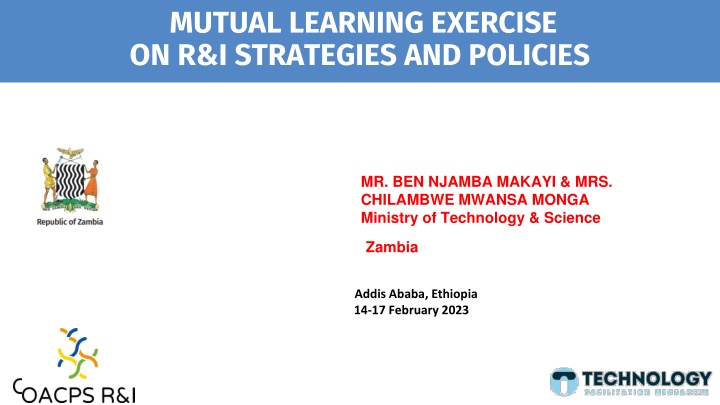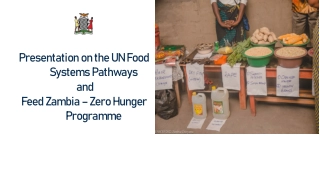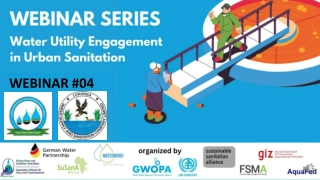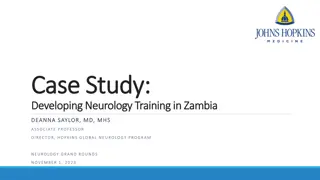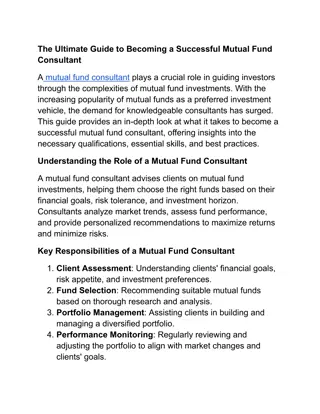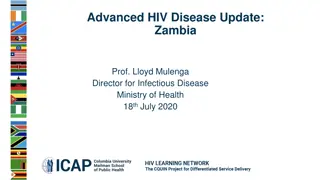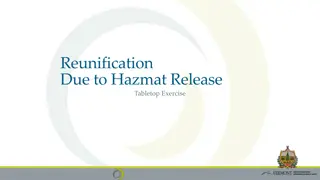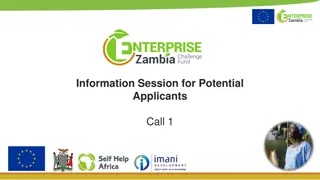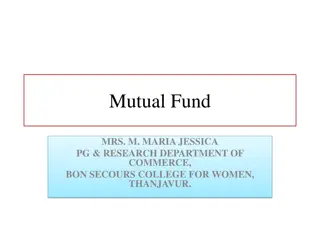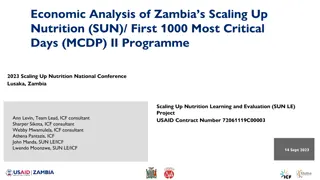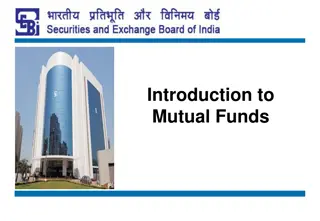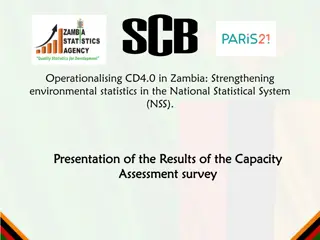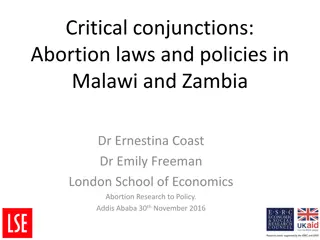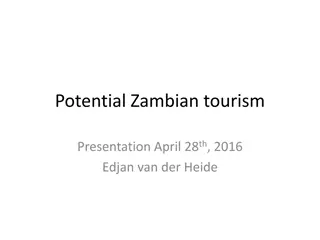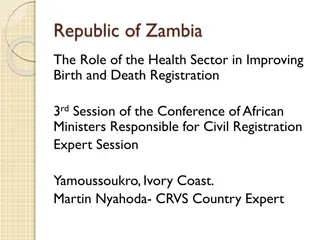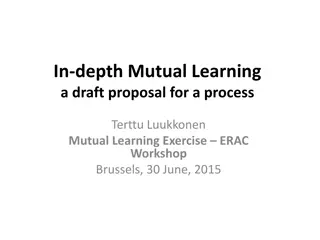R&I Strategies and Policies in Zambia: Mutual Learning Exercise
This mutual learning exercise focuses on the research and innovation (R&I) strategies and policies in Zambia, specifically exploring the status of R&I policies, effectiveness of monitoring and evaluation, development challenges, and alignment with priority areas. It highlights the main actors and stakeholders within the R&I ecosystem, emphasizing the importance of science, technology, and innovation for national development.
Uploaded on Mar 12, 2025 | 1 Views
Download Presentation

Please find below an Image/Link to download the presentation.
The content on the website is provided AS IS for your information and personal use only. It may not be sold, licensed, or shared on other websites without obtaining consent from the author.If you encounter any issues during the download, it is possible that the publisher has removed the file from their server.
You are allowed to download the files provided on this website for personal or commercial use, subject to the condition that they are used lawfully. All files are the property of their respective owners.
The content on the website is provided AS IS for your information and personal use only. It may not be sold, licensed, or shared on other websites without obtaining consent from the author.
E N D
Presentation Transcript
MUTUAL LEARNING EXERCISE ON R&I STRATEGIES AND POLICIES MR. BEN NJAMBA MAKAYI & MRS. CHILAMBWE MWANSA MONGA Ministry of Technology & Science Zambia Addis Ababa, Ethiopia 14-17 February 2023
Slide 1: Background and country context Objective: To provide context and an overview of the R&I Ecosystem Main guiding questions: What are the key R&I and/or STI background and contextual factors that are relevant to this MLE? Research and innovation (R&I) is a foundation of excellent science and the cornerstone of societal trust in researchers and research institutions.Currently, Zambia s long term focus is embedded in the Vision 2030 whose aim is to attain the status of a prosperous middle income country by 2030 . The sector vision for science and technology states that Zambia should be A nation in which science, technology and innovation are the driving forces in national development and competes globally by 2030 . In 2021, Zambia placed a premium on STI by the creation of the Ministry of Technology and Science. What is the status of your R&I and/or STI policy? The 2020 National STI Policy is currently undergoing review to ensure alignment to the 8th National Development Plan (8NDP) A Zero Draft National Research Agenda (NRA) is being aligned to the 8NDP and the STI Policy once review is complete. In the NRA issues of R&I feature prominently. Further, an Innovation Strategy is also being developed in the quest to improve the country s innovativeness. How effective is the monitoring and evaluation of the STI policy? A STI Survey Tool is being developed and scheduled to be carried out by December 2023. This will lead into the creation of the STI Database and in the process provide an effective M&E of the STI. Optional questions: What are the main development challenges in your country? Limited State of the Art STI infrastructure and equipment Limited financing of STI e.g. 1% allocation of Research and Development (R&D) of the countries GDP not being adhered to How do the development challenges align with priority areas for R&I and/STI policy interventions in your country? A proposal to develop a National Research Fund (NRF) is contained in the STI Policy being reviewed, if this is approved, it
Slide 2: Understanding the R&I (and STI) Ecosystem Objective: To understand the main R&I ecosystem actors and stakeholders in your country Guiding question: who are the main R&I / STI ecosystem actors and stakeholders in your country? List the actors and stakeholders under the following broad categories: Government, ministries i.e. Ministries of Technology and Science, Agriculture, Livestock and Fisheries, Energy, Water Resource Development, Green Economy and Environment, Finance and National Planning, Local Government, Commerce Trade and Industry and Small Medium Enterprises and public agencies i.e. National Technology Business Centre (NTBC), National Science & Technology Council (NSTC), National Institute for Scientific and Industrial Research (NISIR), National Remote Sensing Centre (NRSC), Zambia Agriculture Research Institute (ZARI), National Health Research Agency (NHRA), Tropical Diseases Research Centre (TDRC), Technology Development Advisory Unit (TDAU), Golden Valley Agricultural Research Trust (GART), Central Veterinary Research Institute (CVRI) that are actively involved in R&I/STI policies Industry, private sector (large and small) Trade Kings, Private Sector Alliance, ZAMBEEF, BongoHive firms, FinTech in Zambia etc. that are actively involved in R&I/STI policies Research, knowledge and skills producers (e.g. universities University of Zambia, Copperbelt University, Mulungushi University, APEX University, Cavendish University and Zambia Academy of Sciences (ZaAS), think tanks), etc. that are actively involved in R&I/STI policies Civil society organisations (CSOs) Zambia Land Alliance, Twikatane Community Foundation i.e. and NGOs i.e. Zambia Environmental Management Agency (ZIEM), regional (at RECs level) SADC, COMESA, Southern African Institute for Policy and Research African i.e. AU, and international organisations i.e. UNCTAD, UNESCO, UNFCCC, NEPAD, UNECA, NAM S&T Center, UNDP, World Bank are actively supporting R&I and STI policies and policymaking processes (formulation, implementation, M&E or governance) Optional question: What are the (nature of the) relationships among the stakeholder groups? Not very well defined
Slide 3: R&I Ecosystem Analysis - I Objective: To understand the strengths of the R&I ecosystem and opportunities for transformation through R&I policy (formulation or implementation) Guiding question: what are the strengths, opportunities, weaknesses and threats in your country's R&I / STI ecosystem? Provide a SWOT Analysis to help illustrate this (a situational analysis) Strengths Vision 2030, states that Zambia should be A nation in which STI are the driving forces in national development and competes globally by 2030 The 8NDP on Development Outcome 1: An Industrialised and Diversified Economy, Strategy J) Promote applied research and development. Availability of the National STI Policy currently being reviewed Existence of STI institutions Existence of policy, legal, institutional and operational frameworks of the STI system Availability of funds such as SRF, STIYF, STPS, TBDF, CDF, CEEC, Availability of pull of scientists and researchers Weaknesses Weak linkages of R&I institutions, Universities & Industry Inability to secure dedicated funding for R&D activities Poor state of the art infrastructure and equipment Policy fragmentation Duplication of research efforts, Low Human capital in STI sector Weak regulatory frameworks in the STI system Weak intergovernmental linkages Weak research capacity Outdated curriculum, not aligned to industry needs Opportunities Availability of Constituency Development Fund (CDF) (R&I to access CDF) National Research Fund (NRF) once approved to provide adequate R&I financing Political will, Government committed by priotizing STI in the NDPs Central regional geographical location of the country (land linked) Threats Low R&I/STI outputs Inadequate fund allocation to R&D Fragmented STI ecosystem Poor enumeration of researchers and innovators Por participation of SMEs in National Innovation System.
Slide 4: R&I Ecosystem Analysis - II Objective: To help identify and assess framework conditions that may foster or hinder transformative change through R&I policy What are the Political, Economic, Social, Technological, Legal (Regulatory) and Environmental factors influencing and/or shaping your country's R&I / STI ecosystem? Provide a PESTLE Analysis (a table should be fine to capture this) Impact on the Institution Positive (Opportunity) Negative (Threat) 1. Political /Policy i. 8NDP provides a clear focus for the STI sector through the following provisions: Strategic Development Areas Economic Transformation and Job Creation Development Outcome 01 An Industrialized and Diversified Economy Strategy: 09 Enhance Digital Capacity Strategy: 10 Promote applied research and development Development Outcome 02: Enhanced citizenry participation in the economy Strategy: 03 Promote technical, vocational and entrepreneurship skills Strategic Development Area : Human and Social Development Development Outcome 01 Improved Education and Skills Development Strategy: 01 Enhance access to quality, equitable and inclusive education Strategy: 02 Improve technical, vocational and entrepreneurship skills Strategy: 04 Enhance science, technology and innovation Optimisation Measures i. Lobby for increased financing to Technology and Science ii. Strengthen collaboration with cooperating partners and the private sector i. mechanism in the STI sector ii. The research & development function has remained fragmented iii. Inadequate qualified human resource Mitigation Measures i. Review the relevant policy and legal frameworks ii. Develop a coordination framework Absence of a coordination A pproval of the 8NDP 2022 to 2026
Impact on the Institution Slide 4: R&I Ecosystem Analysis - II Contd Positive (Opportunity) Negative (Threat) 1. Political /Policy i. for science Dedicated Ministry Technology i. ii. iii. Dedicated Ministry for Technology & science Realignment of policy, legal and institutional frameworks Repositioning skills development to respond to the country s focus on Industrialization and digitization for job and wealth creation Actualize Digital Transformation i. Curriculum not responsive to the needs of industry The research & development function has fragmented The & ii. remained iv. iii. Optimisation Measures Mitigation Measures Develop a technical, vocational and entrepreneurship skills development plan I. Review frameworks policy and legal i. ii. Lobby for increased financing Review and update all policies and institutional frameworks ii. Develop an R&D coordination framework 2. Economic I. programme Debt sustainability i. Consistent financing of programs 1. Misapplication of resources Optimisation Measures Mitigation Measures ii. iii. iv. Development and implementation of annual work plans Enhance capacity to undertake planned activities Allocation of resources to planned activities I. Enhancing management system the financial
Slide 4: R&I Ecosystem Analysis - II Contd Impact on the Institution Positive (Opportunity) Negative (Threat) 1. Economic Ii. Increased allocation of CDF to constituencies i. ii. Increased revenue for TEVET institutions Potential source of funds for TEVET, Science and ICT programmes Increased enrolments in TVET due to the CDF Bursary 1. Inadequate capacities (lecturers, equipment and infrastructure) in most TVET institutions to enrolments under CDF accommodate the increased iii. Mitigation Measures Optimisation Measures i. ii. Infrastructure development Staff development i. Development and implementation of annual work plans And Capacity for teaching staff ii. Allocation of resources to planned activities Introduction of demand driven courses in TVET institutions iii. Incentives for lecturers iv. Mitigation Measures Iii. Fluctuations in the exchange rate The Fluctuating interest rates Optimisation Measures 1. Increase in the cost of goods and services in relation to the budget. The high cost of infrastructure projects under the Ministry due to delayed completion 1. Rationalising and prioritising the use of available resources 2.
Slide 4: R&I Ecosystem Analysis - II Contd Impact on the Institution Positive (Opportunity) Negative (Threat) 3. Social I. Awareness technology science issues of 1. 2. 3. 4. Increased enrolments Job creation Improved perception of TVET Increased utilization of technologies and innovations 1. 2. 3. 4. Inadequate students and staff infrastructure Negative cultural norms and myths staff inadequacies Inadequate Training equipment and learning materials and Optimisation Measures Mitigation Measures 1. 2. 3. Increased bursary funding Enhancing capacities in TVET institutions Strengthen linkages with industry and other stakeholders i. ii. iii. iv. Infrastructure development and rehabilitation Increased advocacy and sensitization on TVET Improved conditions of service and staff development Expand institutional establishment II. training Awareness of skills Increased enrolments Job creation Improved perception of TVET Increased utilization of technologies and innovations Inadequate students and staff infrastructure Negative cultural norms and myths staff inadequacies Inadequate Training equipment and learning materials 1. 2. 3. 4. 1. 2. 3. 4. Optimisation Measures Mitigation Measures Increased bursary funding Enhancing capacities in TVET institutions Strengthen linkages with industry and other stakeholders Infrastructure development and rehabilitation Increased advocacy and sensitization on TVET Improved conditions of service and staff development Expand institutional establishment 1. 2. 3. i. ii. iii.
Slide 4: R&I Ecosystem Analysis - II Contd Impact on the Institution Positive (Opportunity) Negative (Threat) 4. Technological 1. Advancements Technology Innovation such as platforms, Intelligence nanotechnology Space Science in Increased innovation resulting in increased productivity Use of E-Platforms for cost effectiveness and communication. Integration of systems in all sectors Optimisation Measures 4. Increased awareness on the use of digital platforms 5. Development of innovative solutions 6. Development of digital infrastructure 1. 2. 3. 1. 2. 3. Inadequate digital infrastructure Lack of capacities to fully utilize digital services The high turnover of certain technologies Mitigation Measures i.Digital Infrastructure development ii.Enhance investment in advanced technologies iii.build capacity in the use of advanced technology. iv.Equipping institution with Digital equipment use of E- Artificial (AI), and 5. Ecological/Environmental Climate change research in mitigating the effects of climate change on the environment Developing Green skills Optimisation Measures 1. Prioritise climate change related research; 2. Engage stakeholders for support in Climate change related Research and Development; 3. Strengthen collaboration with stakeholders in Climate change related Research and Development; and 4. Continue monitoring the mainstreaming of Climate Change in the curriculum 5. Enhancing green practices Climate issues drought, floods and high temperature negatively affecting the environment. change such Weak climate change adaptability Lack of mechanism for disposal e-waste 1. 1. 1. 2. as 2. Mitigation Measures promote utilisation of alternative sources of energy prioritise research in alternative sources of energy Develop a mechanism for disposal and recycling of e- waste 3. 4. 5.
Slide 4: R&I Ecosystem Analysis - II Contd Impact on the Institution Positive (Opportunity) Negative (Threat) 6. Legal Legal Frameworks Legal frameworks that respond to the mandate of the ministry and policy environment Enhanced sector growth through regulation 1. Legal frameworks not aligned with the current mandate and policies 1. STI Act No. 26 of 1997 2. Mitigation Measures 1. Ionizing Radiation Protection Act, No 16 of 2005 Optimisation Measures 2. TEVET Act No. 13 of 1998 2. Align Legal frameworks with the current mandate and policies Alignment of policies to Legal frameworks Development of relevant regulations Enhanced development cooperation 3. 4. 5. 3. The Postal Services Act No 22 of 2009 4. The Telecommunications Act No 15 of 2009 Information and Communications 5. Cyber Security and Cyber Crimes Act No. 2 of 2021 Need to enhance develpment cooperation 6. Optional question: Could other analytical approach(es), other than PESTLE, be more useful in your country context? If yes, what are they?
Slide 5: Transformation and Development Impacts Objective: To help establish links to the broader/global context of the SDGs The world is in a transformation era, as encapsulated in the SDGs framework transition towards sustainability, inclusivity, gender equality, reduced inequality, cleaner environment, etc. R&I/STI policies have a role to play in realising the SDGs SDG SDG Indicator What done to achieve these transformations and development impacts is being What development impacts does your country seek to achieve through R&I and 2020 National STI Policy transformations and What policy instruments are being deployed and implemented? research and innovation funds) What challenges & lessons have been gathered transformation efforts to achieve the desired dvpt in your and (e.g. journey 1.b Create sound policy frameworks national ,regional & international levels, based on pro-poor gender -sensitive development strategies Enabling environment from 30% to 70% ratio in favour of females Provision of the STPS, STIYF through issuing research calls Limited funding towards R&I Limited private Industryparticipation Weak linkage of cooperating partners Obj 2. To strengthen and build the human resource capacity in STI. Measures a. Ensure that 60% of all scholarships allocated to technology and innovation Measure e. participation of women and the girl-child in STI Goal poverty forms everywhere 1 End all e.g. sector & in at the STPS are science & Promote the Strategic Research (SRF) dedicated agriculture thematic area Provision of hte SRF through issuing research calls Limited funding towards R&I Limited private Industryparticipation Weak linkage of cooperating partners Obj5 To improve investment and funding to STI Measure b.Provide incentives stimulate investments research by the private sector and industry Increase allocation for R&D Goal hunger food improved nutrition & sustainable agriculture 2. End 2.a Increase technology development & plant & livestock gene banks in order to enhance agricultural productive Fund with of sector & achieve security & to in promote
Slide 5: Transformation and Development Impacts Contd. Objective: To help establish links to the broader/global context of the SDGs The world is in a transformation era, as encapsulated in the SDGs framework transition towards sustainability, inclusivity, gender equality, reduced inequality, cleaner environment, etc. R&I/STI policies have a role to play in realising the SDGs SDG SDG Indicator What done to achieve these transformations and development impacts is being What transformations and development impacts does your country achieve through R&I and 2020 National STI Policy What policy instruments are being deployed and implemented? research and innovation funds) What challenges & lessons have been gathered in your transformation efforts to achieve the desired dvpt seek to (e.g. journey and Limited funding towards R&I Limited private Industryparticipation Weak linkage of cooperating partners Obj 2. To strengthen and build the human resource capacity in Technology Innovation Measure c.Promote professional development and appropriate balance in STI Goal 4. Ensure inclusive & equitable quality education & promote lifelong learning opportunities for all By 2030, ensure equal access for all women & men to affordable & quality technical, vocational & tertiary education, including university Skills Development Fund (SDF) availability In the SDF, there is dedicated thematic area for funding R&I sector & Science, and continuous skills Limited funding towards R&I Limited private Industryparticipation Weak linkage of cooperating partners Obj investment and funding to STI Measure a.Increase Research Financing Local and 5. To improve Goal7.Ensure access to affordable, reliable, sustainable and modern energy for all By 2030,enhance international cooperation facilitate access to clean energy research and technology, including renewable energy, energy efficiency & SRF availability Nuclear Energy Programme for clean renewable energy In the SRF availability Energy is one of the thematic areas Investment in Nuclear Energy infrastructure and creation of Nuclear Project Implementation sector & Grant by International
Slide 5: Transformation and Development Impacts Contd. Objective: To help establish links to the broader/global context of the SDGs The world is in a transformation era, as encapsulated in the SDGs framework transition towards sustainability, inclusivity, gender equality, reduced inequality, cleaner environment, etc. R&I/STI policies have a role to play in realising the SDGs SDG SDG Indicator What done to achieve these transformations and development impacts is being What transformations and development impacts does your country achieve through R&I and 2020 National STI Policy What instruments are being deployed implemented? research innovation funds) policy What challenges & lessons have been gathered in your transformation efforts to achieve the desired dvpt seek to and (e.g. and journey and Limited funding towards R&I Limited private Industryparticipation Weak linkage of cooperating partners Obj investment and funding to STI Measure e.Facilitate construction equipping facilities; 5. To improve Goal 9.Build resilient infrastructure, promote inclusive and sustainable industrialization & foster innovation 9.5 Enhance scientific research,upgrade the technological capabilities of industrial sectors in all countries, in particular developing countries, including, by 2030, encouraging innovation &substantially increasing the # of R&D workers per 1million people & public &private R&D spending Construction of modern scientific infrastructure at National Institute for Scientific & Industrial Research (NISIR) Government budgetory allocation sector & the and R&D of Availability of the STPS Issuing calls for the STPS Limited funding towards R&I Limited private Industryparticipation Weak linkage of cooperating partners Obj investment and funding to STI Measure a.Increase Research Financing 5. To improve 9.b Support domestic technology dvpt, R&I in developing countries, including by ensuring a conducive policy environment for, inte Availability of the TBDF Issuing calls for the TBDF sector & Grant by
Slide 5: Conclusion insights for MLE Objective: To help summarise the key messages and insights from your country presentation Guiding question: What are the three (3) main recommendations/lessons on R&I policy from your country that can inform mutual / policy learning? 1. Enhance linkage of universities, R&I institutions and Industry for effective STI implementation 2. Increasing to 1% of GDP for R&I financing 3. Increasing private sector and industry participation in the construction of STI infrastructure and equipment to support government efforts Optional question: What are the 3 best practices on R&I policy from your country that you can share? 1. Availability of the STI Policy aligned to the SDGs, Zambian Vision 2030, 8NDP 2. Availability of the Ministry of Technology and Science 3. Availability of dedicated funds e.g. SRF, STIYF, TBDF, STPS assisting in financing R&I and Human Resource development To what extent could these recommendations or lessons be transferable/generalisable within the African context and under what conditions? Target of 1% financing of the GDP dedicated for STI is very low in most countries What are three major gaps in STI policy instruments? Policy fragmentation Duplication of research efforts, Low Human capital in STI sector Weak regulatory frameworks in the STI system Weak intergovernmental linkages
Slide 5: References (optional) Kindly provide a list of references or access to relevant information and data/evidence Weblinks, where applicable, will be ok
